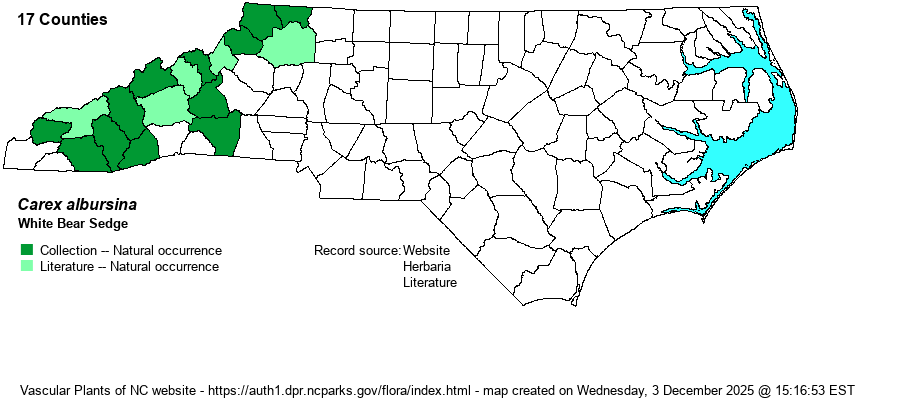| Author | Sheldon | |
| Distribution | Low to middle elevations in the Mountains and upper Piedmont. Several reports from very rich slopes along the Roanoke River in Halifax and Northampton counties, of "probable C. albursina", might be correct (based on the VA range and habitat), but apparently no specimens have been collected to verify these suggested identifications. Certainly, to be looked for in VA border counties in the Piedmont and northwestern Coastal Plain (Roanoke River).
VT to MN south to northern GA and eastern OK. | |
| Abundance | Uncommon to frequent. The S2 State Rank, assigned by the NCNHP, seems conservative, and the editors suggest S2S3, if not even S3. It is currently a Watch List species, but the wide range in the Mountains suggests that such a designation is not necessary. | |
| Habitat | Cove forests and other nutrient-rich montane forests -- over high pH soil. |
| Phenology | Flowering and fruiting April-June. | |
| Identification | White Bear Sedge is readily identified by its overall pale, glaucescent green color, very wide leaves up to 1.5 inches (40 mm), loosely flowered spikes, and abruptly bent perigynia beaks. | |
| Taxonomic Comments | None
The genus Carex is the largest in North America, and among the largest in the world. In temperate and boreal regions, Carex is often the dominant or co-dominant ground layer in many habitats. Seeds (achenes) are valuable food for birds and small mammals, while foliage is used by birds and mammals to make nests and as food by mammals. Species of Carex often look vastly different from one another -- spikes erect vs. drooping, tiny inflorescence vs. whopping, culms leafy vs. naked, perigynia beaked vs. beakless, stems densely bunched vs. single, etc. The genus has been divided into many sections (or groups), based on shared characters; some taxonomists have suggested that these be different genera, but that proves unworkable (so far). All Carex share the feature of a perigynium (an outer covering) which completely surrounds the achene (seed). This covering may fit tightly or loosely (like a small bladder), depending on which group or species. Details of perigynia shape, ornamentation, presence and size of beak, number of striations (or veins) are all important ID features. In recent years Rob Naczi and colleagues have stressed the importance of arrangement of perigynia -- whether spiral (3+ ranks) or distichous (2-ranked) -- and have named a number of new species as well as split off some older synonyms. Therefore, RAB's (1968) key, excellent for its time, can only be used in a general way today. Members of some sections of Carex are difficult to key out (notably Ovales, Laxiflorae, Griseae); this is in part due to variation among individuals of a species, or failings of the key. FNA has drawings of most species and some species may be found in two or more places within a key, to acount for variability. New species to NC, and new to science(!), continue to be found in NC. | |
| Other Common Name(s) | None | |
| State Rank | S2 [S2S3] | |
| Global Rank | G5 | |
| State Status | W7 | |
| US Status | | |
| USACE-agcp | | |
| USACE-emp | | |

